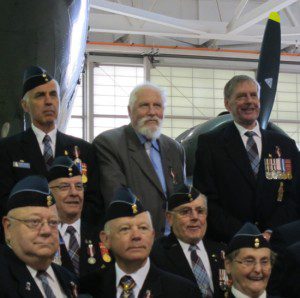
I sat elbow-to-elbow with history last Sunday. Many seated around me had piloted military aircraft in hostile skies. Others had gone aloft as Royal Canadian Air Force navigators, radio operators, gunners and flight engineers. But just as many had made history in the ranks of the volunteer association that gathers, preserves and celebrates the romance of flight in peacetime – the Air Force Association of Canada. Closest to me (and equally close to that history) sat Hugh Halliday, eminent Canadian air historian. We talked about current writing projects. It turned out he had research I needed and he offered it to me without question, without thought of compensation.
“The best way to preserve history,” Halliday said, “is to share it.”
Hugh Halliday and I sat in the audience at Hamilton’s Canadian Warplane Heritage Museum, last Sunday, as part of a ceremony to acknowledge just that sort of gesture. Some months ago, the Governor General’s office had charged the Air Force Association of Canada with the responsibility of honouring the Queen’s 60 years on the throne. The GG wanted the AFAC to choose several dozen of its many volunteers as deserving recipients of the Queen Elizabeth II Diamond Jubilee Medal.
“The medal is a visible and tangible way to recognize outstanding Canadians,” Dean Black, the executive director of the AFAC, said.
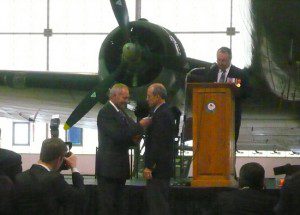
Black stood on a podium beneath the nose of Second World War vintage DC-3 transport plane as he addressed the assembly of medal recipients and their families. One by one he invited men and women from the AFAC to the podium to be recognized for their service. Joining him was Senator Joseph Day (New Brunswick) to present the medals on behalf of Her Majesty. There were association administrators, fundraisers, chapter presidents and VPs, and long-serving members who, as Black said, “have built … this caring society and country through their service and achievements.”
But at a certain point in the presentations, Dean Black paused a moment. Then, making a special point, he emphasized the work of aviation historians. He talked about the need to document air force history, to capture its past in words and images, and to offer Canadians an interpretation of that history to keep it alive. That’s when he called forward Hugh Halliday. Based in Ottawa, Halliday had served as the RCAF’s air historian (1960 to 1965), with the Canadian Forces Directorate of History (1965-68), and as curator of war art, posters and photographs at the Canadian War Museum (1974-95).
Wonderful credentials worth recognizing, but for me Halliday is a walking encyclopedia of military aviation people, events, awards and statistics. He’s the author of a dozen or more books on Canadian history. And because, in addition, he’s always eager to offer his research freely, he received the Diamond Jubilee Medal on Sunday.
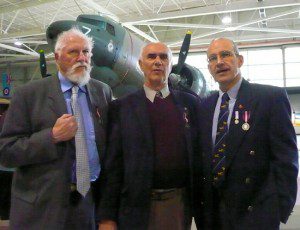
Also receiving a medal was Larry Milberry. I’ve always admired the way Milberry got his aviation-writing career off the ground, so to speak. For 10 years, as he taught high school in the Toronto Catholic school system, Milberry assembled the data and wrote as a hobby his definitive book, “Aviation in Canada,” published in 1979. He realized this was his calling and launched his independent writing/publishing firm CANAV Books from his home in downtown Toronto. I remember visiting him one day not long after he launched his one-man, mail-order publishing firm. He met me at the door of his narrow Beach-area home and walked me to his kitchen for a coffee.
“Mind the piles of books in the hallway,” he said. “They’ll all be mailed in the next day or two … from here to all corners of the globe.”
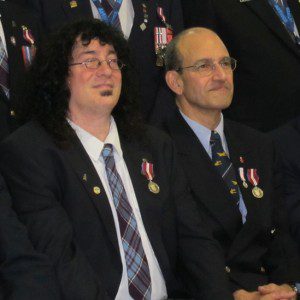
Later during the Sunday medal ceremony, I joined an aviation historian in a group photograph. Quebecer Jerry Fielden works in photography and tattoo art, but his passion is aviation. In particular, he has spent much of his free time in recent years compiling the history of RCAF 438 Squadron, a helicopter unit with service dating back to the 1930s. His efforts in preserving an extraordinary story (in French) were also recognized on Sunday with a Diamond Jubilee Medal.
“I feel privileged to be in such good company,” Fielden said.
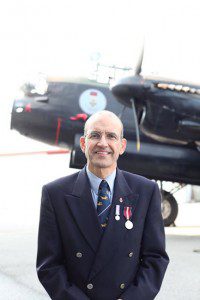
In spite of the regal importance attached to every Jubilee medal and each recipient (including myself) there on Sunday, the Air Force Association had a final gift to bestow. As the medal ceremony came to a close, the AFAC announced it was awarding the Canadian Warplane Heritage Museum and its work in preserving aviation history, a $35,000 grant. It was an exclamation point for the day, I thought.
One day, when my grandchildren come back to the museum to remember the day their grandfather was honoured for recording history, they will benefit from the gifts of a society (and a monarch) that cared enough to share the past with the future.
Great story, and well deserved recognition. Having worked with Vic Johnson and Hugh Halliday over the years, I’m very pleased to see that they were properly recognized for their significant contributions to Canada’s history. Bravo !!
Ray Stone
Thank you Ted for an inspired description of the event, I was truly honoured to be in such distinguished company and to have a chance to sit next to you and have a chat during the group shot.
I also am a musician BTW for those of you who would like to check out what I do, I’m at http://www.arapacis.com
Cheers and pleased!
Jerry Fielden
As the mother of Jerry Fielden, also my editor, I was so proud to see him receive his medal on October the 14th. Jerry received his BA with honours in history at McGill, and his masters in archival technology, and has over the years been helpful in supllyhing me with any historical data I needed for the books I have written, especially the historical novel ‘Palatine Hill’ spanning the years from 1681 to 1927, in the lives of the Secords and Servos families, two founding families of Niagara-on-the-Lake, both families serving in ongong wars in that area, especially the War of 1812. NOTL is more than a quaint town, I discovered, it is a hotbed of history. So glad that Jerry had a chance to chat with you last Sunday, and thank you for your fine account of the event. Halliday and his wife Monique sat behind me during the ceremony and after that Monique and I had a great chat in French about the strong and courageous women in Canadian history.
Yours very truly, Charlotte Fielden, founding member of The Writers’ Union of Canada and The Playwrights Guild of Canada.
Ted;
Your Honour is richly deserved.
I was delighted to see LGen Lloyd Campbell included in the lead photo, front and centre, accompanying the article. He has a long-time track record connected to the history of the RCAF. When I served in 419 Sqn as SAMEO when he was the CO, he fostered a substantial link to the squadron’s past, including connecting with a long-standing 419 Sqn Groundcrew organization that had held together informally since the Second World War. He led a deployment with four CF-5s from Cold Lake to Baden commemorating the Sqn’s time there on CF-100s, and, while there, we relived the burial of Bruce the Moose next to one of the HASs. Unfortunately, due to posting, LGen Campbell narrowly missed the rollout ceremony for the Mynarski Lancaster, and because of a delay of the Squadron’s Colours ceremony, participating in the actual colours presentation at which the Lancaster was a star attraction. (A B-17 did a fly by but didn’t land.) Moosa Aswayeta, sir.
Dear Ted, Well Done! and congrats on your Diamond Jubilee Medal. The others whom I know are Hugh Halliday,Vic Johnson, and Larry Milberry.
Well done to all of you!
It is said that in the olden times of our native North American tribes that one member of each tribe was entrusted with the stories, recent and old, of all that had become the history of their tribe and nation. Even then they realized that if their nation was to be strong for the future they had to hold on to the past and pass it on to their future generations, even if it was around a campfire or just a verbal “database”. The databases have changed in form and style but not the importance to save our history
If you wish to know where you are going, then you must know where you have been, or “the only thing new in this world is the history you do not know”.
So, bless-ed are you, the story tellers, and in our line of work, “per ardua ad astra”. Warm regards to all of you, Karl Kjarsgaard